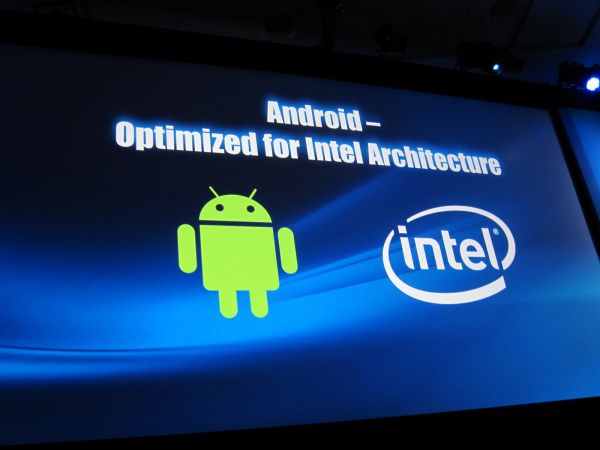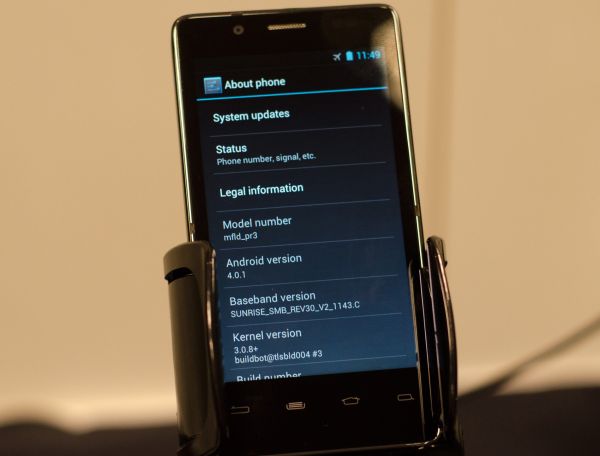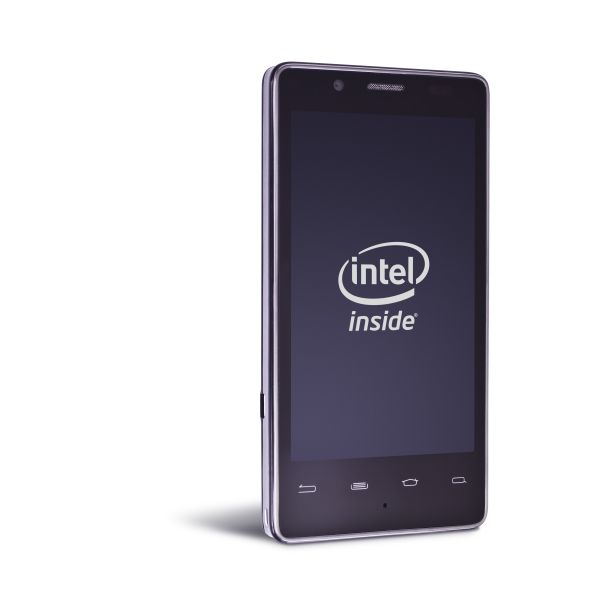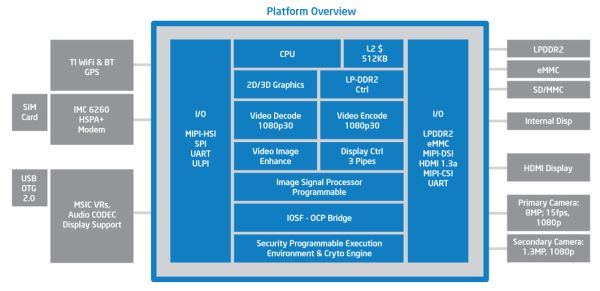Intel's Medfield & Atom Z2460 Arrive for Smartphones: It's Finally Here
by Anand Lal Shimpi on January 10, 2012 8:00 PM ESTWhat's Different This Time Around: Google & A Sweet Reference Platform
Intel has been talking about getting into smartphones for a couple of years now, but thus far it hasn't been able to secure a single design or partnership that that resulted in a product actually coming to market. This time around, things are different. The major change? Focus, and Google.
Intel originally had ambitions of enabling its own mobile OS with the help of Nokia (Moblin/MeeGo). Intel also wanted to support Android as well, however its attention was clearly more focused on the Moblin/MeeGo effort. Similar to the wake up call that pushed NVIDIA to focus exclusively on Android, Intel has now done the same.
At IDF last year Intel and Google announced a partnership and the intention to bring all future versions of Android, starting with Gingerbread, to x86. Since then Intel has ramped up the software engineering engine, going into the Android source code (Gingerbread, Honeycomb and now ICS) and fixing bugs. Intel's goal is to deliver the most stable version of Android as a result of its efforts. Intel is also submitting its changes upstream to the AOSP, which should help improve the Android experience even on ARM platforms.
Under the leadership of Mike Bell (formerly of Apple and Palm), Intel has also created an extremely polished Medfield reference design. This is the same design shown off at IDF last year (apparently there's an even thinner one floating around somewhere), but what separates it from other reference designs we've seen from SoC vendors is that the Medfield reference platform was designed to be a polished phone that could theoretically be rebranded and resold.
Intel knew the onus was on itself to prove that Medfield, Atom and even just x86 was power efficient enough to be delivered in a compelling form factor with competitive battery life. Paul Otellini gave Mike carte blanche access to any of Intel's resources. Instead of having to work with existing Intel groups, Mike was allowed to assemble his dream team of engineers. The team Mike built is what he felt he needed to not only bring Medfield to market, but also to build the a first class Atom based smartphone.
The result is this:
Internally it features Intel's own XMM 6260 HSPA+ modem. Intel claims LTE is on the way although there's no ETA on that.
WiFi in the reference design is provided by TI's 1283 controller. Intel's wireless team does not have a a WiFi solution that's low power enough to work in a smartphone, although after the recent restructuring the team has now been tasked with building an ultra low power solution that can.
The display is a somewhat unusual 1024 x 600 panel, with support for 1080p30 (and 1080i60) output via HDMI. The SoC specs are identical to what I've already discussed: 1.6GHz max CPU clock and a 400MHz GPU clock.
The reference platform is not only smartphone sized, but Intel has built its own qualification labs that mirror those of the carriers to ensure quality and convince its customers of the platform's legitimacy. In essence, Intel has built its own miniature smartphone design and test center.
The Medfield reference platform is available for use by any of Intel's customers, and indeed that's what's already happening. Lenovo's K800 is based on a modified version of Intel's reference platform, and I wouldn't be surprised if more aren't on the way.
All of this sounds a lot like Intel's efforts in the motherboard space over a decade ago where it started providing motherboard manufacturers with reference designs that they could modify if they desired. The effort helped significantly reduce time to market and allowed the motherboard makers to focus more on specializing on what they were good at.
The Medfield reference platform is designed to do the very same for smartphones. Intel wants to provide its partners with a well designed, stable smartphone platform. If they choose to use it, they can shave off a significant amount of development time and spend more of their time on software or simply bring a good reference phone to market in a quick fashion. I'm not entirely sure I've seen many players in the Android space that are actually all that great at software development, but Intel believes anything that shortens time to market will be appreciated.
I asked Intel if it has any plans to offer the reference platform unlocked, direct to customers. Unfortunately the answer at this point is still no. I suspect that Intel is more interested in building its customer base rather than circumventing it.
















164 Comments
View All Comments
Dribble - Thursday, January 12, 2012 - link
I see fudzilla managed to get a BenchmarkPi score:The HTC Thunderbolt (Snapdragon 1GHz): 888ms
Lenovo K800 (1.6Ghz Atom): 743ms
LG Optimus 2X (Tegra 2): 550ms
french toast - Thursday, January 12, 2012 - link
Yea when you get past the Intel marketing and start digging you find its not really thtat special when compared to last years designs. hers some more. Intel medfield 3791 quadrant. samsung galaxy note @1.4ghz 4300+http://www.youtube.com/watch?v=k2SzV_bl76k
If you level the clock speed and use the same software on the ARMs you would get better than this in cafeinemark;
http://androidandme.com/2012/01/news/intel-medfiel...
Add that to the other links i posted earlier, and do some multithreaded tests and the Atom doesn't look that impressive compared to duel core A9s on 40nm...let alone quad core kraits on 28nm...
dwade123 - Thursday, January 12, 2012 - link
Give a a few years and we 'll see Intel dominating this market.Targon - Thursday, January 12, 2012 - link
This is a single-core chip....in an environment that is already going to be dominated by dual-core chips by the time it is released. What is Intel trying to do, emulate Palm, who would announce something that sounds great, then a year later when product is actually shipping, seems pretty weak? Palm died as a result(even though it was under the HP umbrella at the end), and Intel is just following that example of what NOT to do.Intel may have process advantages, but Intel doesn't do much when it comes to real innovation.
happycamperjack - Thursday, January 12, 2012 - link
Judging from the BrowserMark and SunSpider, Medfield has tegra 3 beat for about 10% to 30% in a more single threaded application. But in a more threaded application such as photo editing apps, some games and also multitasking, Tegra 3 would come out on top. Not to mention Tegra 3 would probably do a lot better in battery life and 3D games as well.But backward compatibility for lower end Windows 8 tablets? Yes please!
Lucian Armasu - Friday, January 13, 2012 - link
A 10% performance different shouldn't be surprising, considering Intel Atom is running at 1.6 Ghz and Tegra 3's first core is running at 1.4 Ghz. This only means that a Cortex A9 core is about as powerful as Atom at the same clock speed. And by the time it's out it will have to compete with Cortex A15, which is twice as powerful as Cortex A9 for the same clock speed. Plus it will be dual core vs the single core Atom. Krait chips should be in the same ballpark as Cortex A15, perhaps a bit weaker, but still much more powerful than Atom.As for the compatibility with Windows 8. I don't understand what's the benefit of that? To use programs that are not optimized for touch? Why? If that was such a big deal, you could already use Windows 7 tablets. Whether Microsoft is pushing for ARM tablets, or x86 tablets, they still have to start from scratch, because they need apps that are fully optimized for touch, and not for the mouse. So in this case x86 has no advantage over ARM, at least not more than it already had in the Windows7-era. And if Microsoft were smart, they'd actually push the ARM tablets instead to compete on battery life.
happycamperjack - Friday, January 13, 2012 - link
You don't understand the benefit of backward compatibility?? Are you serious?? How about instant access to biggest libraries of applications ever while Windows 8 apps have time to mature.As for the performance of the chip, I was disappointed about Intel's SoC until I realize that it's actually running android 2.3. So it would be more fair to compare the performance against another Android 2.3, Galaxy S II, which benchmarked at half the speed of Intel! But it's GPU is definitely garbage.
thunng8 - Friday, January 13, 2012 - link
The Motorola RAZR is also running 2.3.french toast - Friday, January 13, 2012 - link
What has been misleading about the Intel pushed benchmarks in this article, is that although the Medfield runs Gingerbread, it also run a heavily updated varient.2.3.7..which according to the boys over at xda, has been optimised to near ICS levels..Note that the phones benchmarked against it run stock Gingerbread which can be noticebely slower on older versions.
Another thing to note, the phones benchmanrked against, also have heavy custom UI skins over the top..aka sense/touchwiz which saps power, hence why uses prefer to root their phone..for that very perforance enhanced reason.
-Where as the Medfield reference phone does not.
If you level all software equal, i very much doubt the Medfield would have a lead in any benchmark, and in some cases would likely lose, such as graphics, multhreaded, and battery use scenarios that stress the cpu.
That is against phones that have been on the market 18months or so by the time Medfield ships AND are lower clocked A9s.
CUEngineer - Friday, January 13, 2012 - link
You guys are hilarious... Obviously there will be an optimized OS version that google and intel worked on, since its using a different ISA then arm, they need to optimize the binaries to do things such as take advantage of instructions intel adds for performance which no ARM IP licenseee company is allowed to do... Any good company will optimize software to run on their hardware to give better results and that is valid...Intel has been doing high performance designs for many years now, ARM just designs their IP to work simple and without consuming much power, so it wouldnt be hard to think that intel analyzes certain performance features differently such as handling hits under misses and taking multiple miss requests without bottlenecking the system... an out of order CPU could make this impact less since other instructions might be able to be scheduled while waiting for the miss to be completed..
Either way all you folks should worry about is how close those power numbers because once intel gets in this space it is going to dominate, and will have attractive offerings since everyone else is basically using the same IP from arm with different wrappers...